A Systematic Review of Psychometric Properties of Knee-Related Outcome Measures Translated, Cross-Culturally Adapted, and Validated in Arabic Language
- PMID: 36141243
- PMCID: PMC9498300
- DOI: 10.3390/healthcare10091631
A Systematic Review of Psychometric Properties of Knee-Related Outcome Measures Translated, Cross-Culturally Adapted, and Validated in Arabic Language
Abstract
During the previous two decades, patient-reported outcome measures (PROMs) have been well tested, and the tools were validated in different languages across the globe. This systematic review aimed to identify the knee disease-specific outcome tools in Arabic and evaluate their methodological quality of psychometric properties of the most promising tools based on the COSMIN checklist and PRISMA guidelines. Articles published in English, from the inception of databases until the date of search (10 August 2022), were included. Articles without at least one psychometric property (reliability, validity, and responsiveness) evaluation, and articles other than in the English language, were excluded from the study. The key terms ["Arabic" AND "Knee" AND ("Questionnaire" OR "Scale")] were used in three databases, i.e., PubMed, Scopus, and Web of Science (WoS) in the advanced search strategy. Key terms were either in the title or abstract for PubMed. Key words were in the topic (TS) for WoS. COSMIN (COnsensus-based Standards for the selection of health Measurement Instruments) risk of bias checklist was used to evaluate the methodological quality of psychometric properties of the Arabic knee-related outcome measures. A total of 99 articles were identified in PubMed, SCOPUS, and WoS. After passing inclusion and exclusion criteria, 20 articles describing 22 scales from five countries were included in this review. The instruments validated in the Arabic language are Western Ontario and McMaster Universities Osteoarthritis Index (WOMAC), knee injury and osteoarthritis outcome score (KOOS), knee outcome survey- activities of daily living scale (KOS-ADLS), Oxford knee score (OKS), anterior knee pain scale, osteoarthritis of knee and hip health-related quality of life (OAKHQoL) scale, Lysholm knee score (LKS), international documentation committee subjective knee form (IKDC), intermittent and constant osteoarthritis pain (ICOAP) questionnaire, Kujala patellofemoral pain scoring system (PFPSS), anterior knee pain scale (AKPS) and osteoarthritis quality of life questionnaire (OAQoL),. All were found to have good test-retest reliability (Intra Correlation Coefficient), internal consistency (Cronbach's alpha), and construct validity (Visual Analog Scale, Short Form-12, RAND-36, etc.). Of 20 instruments available to assess self-reported knee symptoms and function, 12 were validated in the Saudi Arabian population. Among them, KOS-ADLS is the best PROM to be used in various knee conditions, followed by KOOS and WOMAC. The assessed methodological quality of evidence says that the knee Arabic PROMs are reliable instruments to evaluate knee symptoms/function.
Keywords: Arabic language; assessment tools; knee; osteoarthritis (OA).
Conflict of interest statement
The authors declare there are no competing interests.
Figures
Similar articles
-
Cross-cultural adaptation and validation of the Arabic version of the knee and hip health-related quality of life (Mini-OAKHQOL) questionnaire in male Saudi patients with osteoarthritis: a methodological observational design.PeerJ. 2024 Sep 25;12:e18122. doi: 10.7717/peerj.18122. eCollection 2024. PeerJ. 2024. PMID: 39346052 Free PMC article.
-
Cross-cultural adaptation and validation of the Saudi Arabic version of the Knee Injury and Osteoarthritis Outcome Score (KOOS).Rheumatol Int. 2018 Aug;38(8):1547-1555. doi: 10.1007/s00296-018-4072-7. Epub 2018 Jun 7. Rheumatol Int. 2018. PMID: 29882042
-
Cross-cultural adaptation, reliability and validity of the Arabic version of the reduced Western Ontario and McMaster Universities Osteoarthritis index in patients with knee osteoarthritis.Disabil Rehabil. 2016;38(7):689-94. doi: 10.3109/09638288.2015.1055380. Epub 2015 Jun 11. Disabil Rehabil. 2016. PMID: 26066566
-
Patient-reported outcome measures following revision knee replacement: a review of PROM instrument utilisation and measurement properties using the COSMIN checklist.BMJ Open. 2021 Oct 21;11(10):e046169. doi: 10.1136/bmjopen-2020-046169. BMJ Open. 2021. PMID: 34675009 Free PMC article. Review.
-
Measures of knee function: International Knee Documentation Committee (IKDC) Subjective Knee Evaluation Form, Knee Injury and Osteoarthritis Outcome Score (KOOS), Knee Injury and Osteoarthritis Outcome Score Physical Function Short Form (KOOS-PS), Knee Outcome Survey Activities of Daily Living Scale (KOS-ADL), Lysholm Knee Scoring Scale, Oxford Knee Score (OKS), Western Ontario and McMaster Universities Osteoarthritis Index (WOMAC), Activity Rating Scale (ARS), and Tegner Activity Score (TAS).Arthritis Care Res (Hoboken). 2011 Nov;63 Suppl 11(0 11):S208-28. doi: 10.1002/acr.20632. Arthritis Care Res (Hoboken). 2011. PMID: 22588746 Free PMC article. Review. No abstract available.
Cited by
-
Use of patient-reported outcome measures after breast reconstruction in low- and middle-income countries: a scoping review.J Patient Rep Outcomes. 2024 Feb 28;8(1):25. doi: 10.1186/s41687-024-00687-y. J Patient Rep Outcomes. 2024. PMID: 38416222 Free PMC article.
-
Arabic-Translated Versions of Patient-Reported Outcome Measures Utilized in Spine Research: A Review of Validated Studies.Cureus. 2023 Oct 1;15(10):e46303. doi: 10.7759/cureus.46303. eCollection 2023 Oct. Cureus. 2023. PMID: 37916239 Free PMC article. Review.
-
Cross-cultural adaptation and validation of the Arabic version of the knee and hip health-related quality of life (Mini-OAKHQOL) questionnaire in male Saudi patients with osteoarthritis: a methodological observational design.PeerJ. 2024 Sep 25;12:e18122. doi: 10.7717/peerj.18122. eCollection 2024. PeerJ. 2024. PMID: 39346052 Free PMC article.
-
Reliability and validity of patient-reported outcome measures in assessing knee osteoarthritis in the Chinese population: A systematic review.Heliyon. 2024 Sep 2;10(18):e36645. doi: 10.1016/j.heliyon.2024.e36645. eCollection 2024 Sep 30. Heliyon. 2024. PMID: 39381238 Free PMC article. Review.
References
-
- Kulandaivelan S., Tigdania N., Ateef M., Chaturvedi R., Joshi S., Malik A., Pahinian A. Prevalence of knee pain and its correlates with specific emphasis on CVD risk factors in Hisar urban population. Int. J. Clin. Rheumtol. 2017;12:91–96.
-
- Ismail A.I., Al-Abdulwahab A.H., Al-Mulhim A.S. Osteoarthritis of knees and obesity in Eastern Saudi Arabia. Saudi Med. J. 2006;27:1742–1744. - PubMed
-
- Safiri S., Kolahi A.-A., Smith E., Hill C., Bettampadi D., Mansournia M.A., Hoy D., Ashrafi-Asgarabad A., Sepidarkish M., Almasi-Hashiani A., et al. Global, regional and national burden of osteoarthritis 1990–2017: A systematic analysis of the Global Burden of Disease Study 2017. Ann. Rheum. Dis. 2020;79:819–828. doi: 10.1136/annrheumdis-2019-216515. - DOI - PubMed
Publication types
LinkOut - more resources
Full Text Sources


